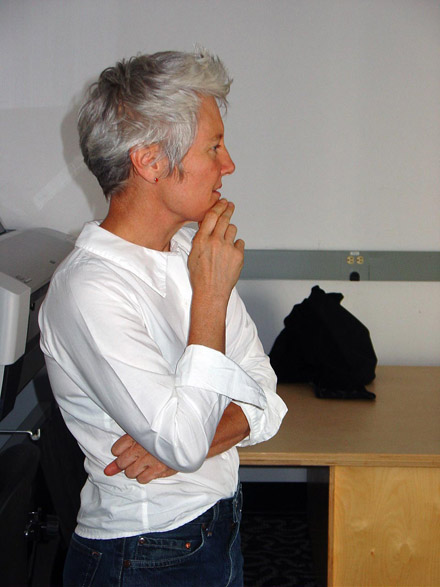"Art Needs To Ask Bigger Questions"
Ann Hamilton's Nomadic Residency at OCAD
Gareth Bate, 2008
Published:
Canvas Magazine, Ontario College of Art & Design, Dec. 2007
Return to Writing Menu

Ann Hamilton at the Ontario College of Art & Design. Photo: Gareth Bate
As a great admirer of Ann Hamilton's work, I was especially lucky to have the opportunity to be her helper during her time in OCAD's Nomadic Residency. She brought an amazing energy, and deep engagement that inspired a lot of people.
While at OCAD, Ann created the Listening Choir with a group of about 20 students. It grew to include many more. I heard Ann describe art as "a social act; a way of being in the world; a dialogue." The project evolved through collaborative experimentation in different locations around OCAD, and then moved out onto the street. As a group we would disperse a few meters apart but remain clearly connected. We stood still with our eyes closed, and listened to the sounds around us. In response to noises we would pivot our bodies in that direction. Slowly turning, often in unison like schools of fish. This would go on for between 5 and 15 minutes.
The Listening Choir was created for Toronto's Nuit Blanche. We began at OCAD where we listened to the demolition of Rirkrit Taravanija's wall blocking the Professional Gallery. We then spent the evening walking around the city, adapting to each site. Along the way new people joined the group.
During her meetings with students, Ann said: "art works by demonstration," and asked the question: "how can art demonstrate an ethic?" The Listening Choir stood in striking contrast with the insanity and circus like atmosphere of Nuit Blanche. Although the energy of the street was exciting, the art was often a let down. It seemed like the crowds were just walking from one thing to the next without ever contemplating the work. The Listening Choir was successful because it encouraged people to stop, take a deep breath, relax, and listen for themselves.
The piece reached its strongest point at the University of Toronto where the conditions were perfect. There was space to distribute, and little car traffic. We stood in two locations – on the road just before Convocation Hall, and in Philosopher's Walk, where we spread out on a hill over three paths. It reminded me of Antony Gormley's existential figure sculptures on the beach.
At times I felt somewhat anxious to join in the festivities rather than stand and listen. However, I quickly realized that this was a truly special experience and far more interesting. Participating was like being in a completely different headspace. You gradually tuned out the ongoing noises and instead remained completely present to the changing sounds. It is a strangely vulnerable experience to stand in public with your eyes closed, and yet be aware of being keenly watched. The beautifully poetic quality and presence of this act received a lot of attention. I attempted to document it from the perspective of a participant by blindly filming as I turned my body towards the sounds. The documentation thus recorded the response of the viewers. We continued until 1:00am when the group got separated in the crowd. Ann really enjoyed her time in Toronto. Her visit to OCAD was inspirational to me, and many other students and staff. I feel really lucky to have had the opportunity to meet her and participate in this wonderful project.
Postscript: In 2010 Toronto's Nuit Blanche celebrated its first five years with a exhibition of highlights from the past. It was like a document of the history of Nuit Blanche. Ann Hamilton's Listening Choir was a largely unplanned and unofficial Nuit Blanche project and thus was not included. I'm not sure the organizers even knew it had occured. But I believe it was one of the most meaningful responses to Nuit Blanche and should be incorporated into that history.
© Gareth Bate, 2011